References
Published online by Cambridge University Press: 05 January 2016
Summary

- Type
- Chapter
- Information
- Demography and Evolutionary Ecology of Hadza Hunter-Gatherers , pp. 461 - 485Publisher: Cambridge University PressPrint publication year: 2016



